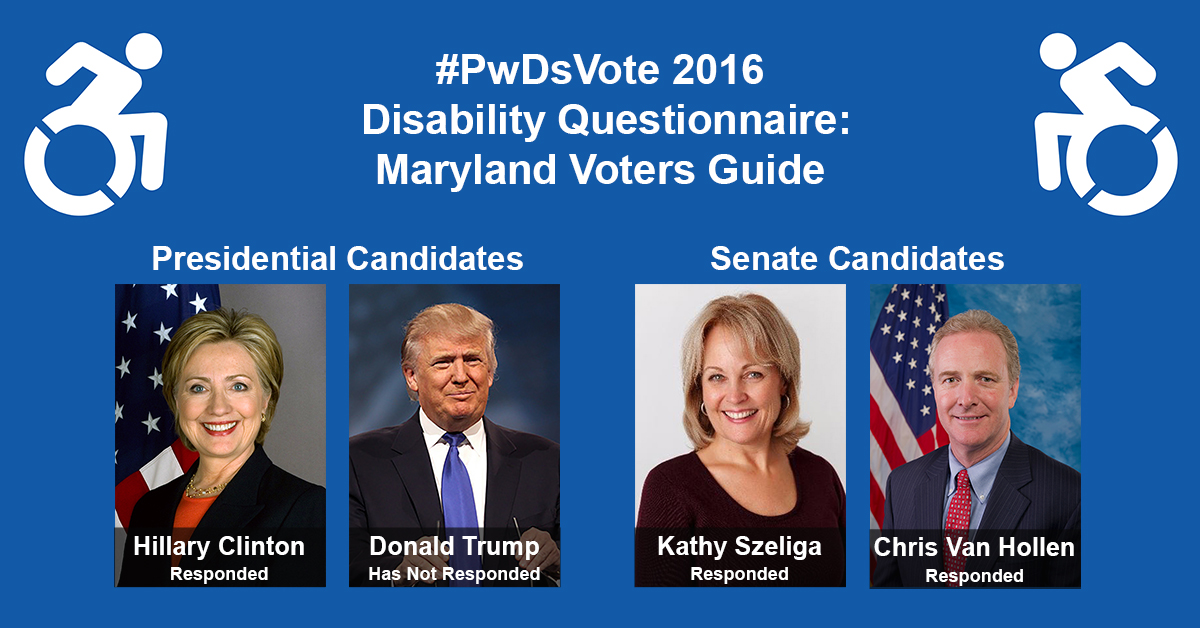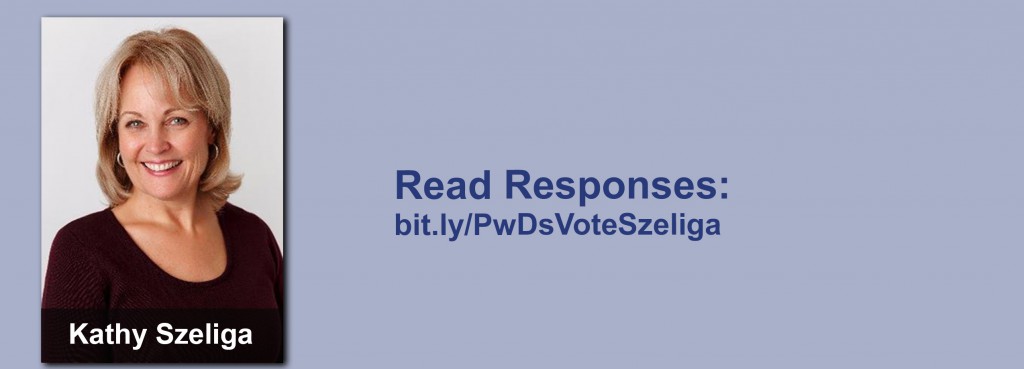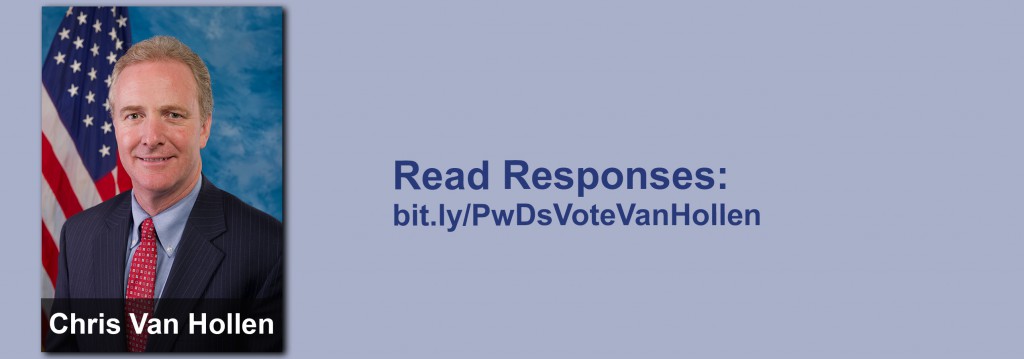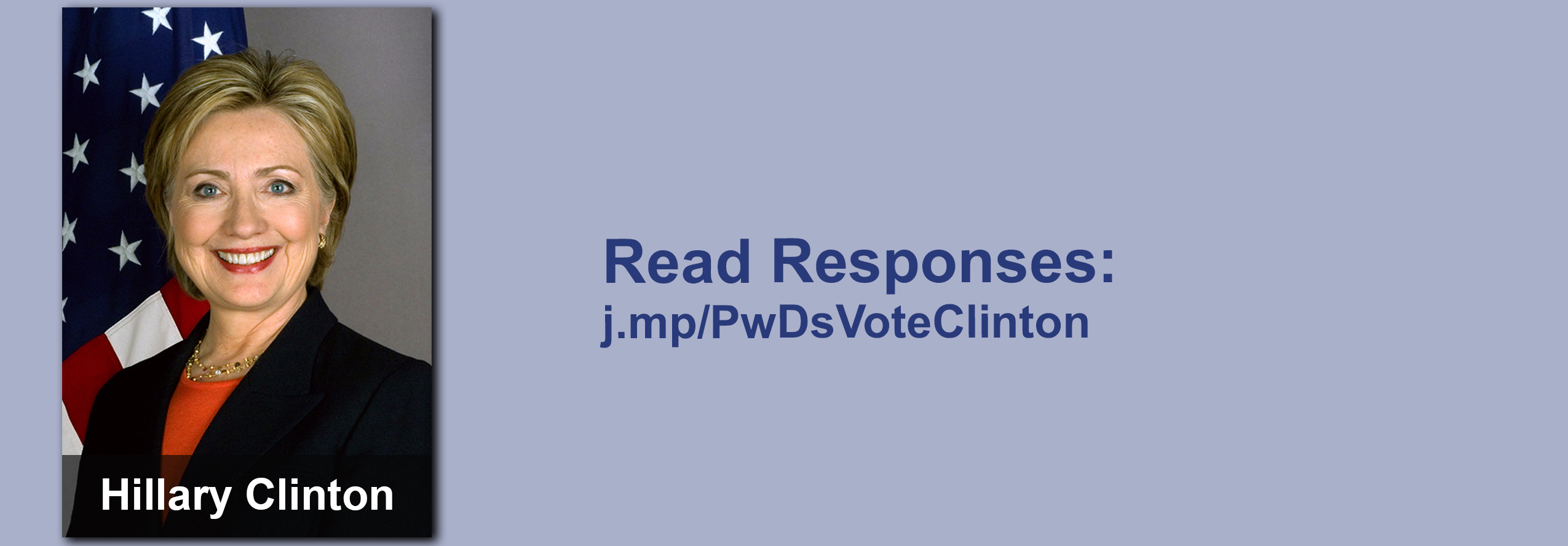Rockville, Md., Oct 11 – As voters get ready to head to the polls in Maryland, RespectAbility has released its Maryland Disability Voter Guide for the upcoming senate and presidential races. Both Republican Del. Kathy Szeliga and Democratic Rep. Chris Van Hollen, who are seeking the state’s open U.S. Senate seat, as well as presidential candidate Hillary Clinton, completed the #PwDsVote Disability Campaign Questionnaire for people with disabilities and have very different solutions to pressing problems. By both Senate candidates filling out the questionnaire, each of them communicates that disability issues matter to them.
The #PwDsVote 2016 Campaign Questionnaires were designed by and for people with disabilities (PwDs) and those who love them to know where candidates stand on key issues. RespectAbility is nonpartisan and does not endorse candidates. The questionnaires are purely for educational purposes as voters go to the polls.
According to a new report from Rutgers University, 35.4 million people with disabilities will be eligible to vote in the November 2016 elections, representing close to one-sixth of the total electorate. That’s an increase of nearly 11 percent since 2008.
The presidential questionnaire was created during the primary season and asked all of the presidential candidates to comment on 16 disability questions. Former Secretary of State Hillary Clinton responded by addressing all of the questions. Despite numerous requests in person and by phone and email, the Trump campaign has not yet filled out the questionnaire. The American Association of People with Disabilities and the National Council on Independent Living also has a nonpartisan presidential questionnaire, which both Clinton and Trump have completed. Libertarian Gary Johnson and Green Party candidate Jill Stein have not filled out either questionnaire.
The down-ballot survey was adapted from the presidential questionnaire to ask gubernatorial candidates 16 questions and senatorial candidates 17 questions. All answers are posted verbatim and in full on The RespectAbility Report, a publication that covers the intersection of disability and politics.
Maryland has an open Senate race and both major-party candidates have responded, allowing the 622,682 citizens with disabilities a chance to compare them on a variety of issues.
The state varies greatly in employment rate of working-age people with disabilities. While 39.1 percent of working-age Marylanders with disabilities statewide are employed (compared to 78 percent of those without disabilities), it’s important to delve below these topline numbers. Fully 47.97 percent of working-age people with disabilities in Montgomery County are employed. However, in Baltimore City, that number drops to just 26.5 percent. Maryland’s voters are looking to know where the candidates stand on important disability issues in order to increase opportunities for competitive, integrated employment for people with disabilities.
In his response, Van Hollen talked about his experience of people with disabilities serving on his staff and through his internship program, informing his views.
“When our nation underestimates or devalues the contributions of this community, we do ourselves a disservice,” he responded. “Therefore, we must always strive to break down barriers, confront stigma, and increase independence and self-determination. We must communicate with employers to share best practices and debunk stereotypes to help them understand ways to integrate their workplaces and take advantage of the talents of those in the disability community. Programs like Project SEARCH and Broad Futures in my Congressional district are making important strides in this critical work.”
Szeliga, who has experience working with ARC Maryland, also spoke out about the need to reduce stigma and discrimination.
“We must make sure that all Americans are treated equally no matter what they look like, where they come from, or if they have a disability,” she responded in the questionnaire. “As the next U.S. Senator from Maryland, I look forward to continuing to work with ARC Maryland and to work with RespectAbility to make sure that people with disabilities are not being discriminated against.”
Fully one-out-of-five Americans have a disability, and 52 percent of likely voters have a loved one with a disability. Only 34 percent of working-age Americans with disabilities have jobs, despite the fact that the vast majority want to work. More than 11 million working age people with disabilities are now living on government benefits in our country.
RespectAbility President Jennifer Laszlo Mizrahi said, “Our community is looking for jobs so we can achieve the American dream, just like anyone else. It is vital for us to know where the candidates stand on economic, stigma, education, safety, transportation, housing, healthcare, foreign affairs and other issues. The candidates have hugely different ideas about how to deal with the issues. Thus, it’s extremely important to read their full answers so you can understand their vast differences.”
Employment Varies Across Maryland
There are 321,409 Marylanders with disabilities who are between the ages of 18-64. Additionally, there are 22,000 Marylanders ages 16-20 with disabilities. More than 90,000 Maryland students have individual education plans (IEPs). However, many Marylanders with disabilities have not yet received a disability diagnosis they need, and thus are not yet receiving the school accommodations and supports that they need to succeed. Many students who might need support to succeed academically instead find themselves trapped into a lifetime of poverty or flowing down the school to prison pipeline.
Today Maryland has the opportunity to work hard to improve outcomes in terms of competitive, integrated employment for people with disabilities. Currently only 39.1 percent of working-age Marylanders with disabilities are employed compared to 78 percent of those without disabilities. View the rankings of all 50 states and compare.
However, looking at the topline numbers of Maryland alone can be misleading. According to the U.S. Census Bureau’s 2010-2012 American Community Survey, fully 47.97 percent of working-age people with disabilities in Montgomery County is employed. However, in Baltimore City, only 26.5 percent are employed. Of those Marylanders with disabilities who are working, many are working only part time or at subminimum wages in sheltered workshops. While these statistics are better than the national average, fully 56,600 working-age Marylanders with disabilities are living on government benefits. This costs close to $2 billion a year in SSDI benefits alone.
Maryland Needs to Improve Outcomes for Citizens With Disabilities
RespectAbility, founded in 2013, is a nonpartisan, nonprofit organization working to end stigmas and advance opportunities for people with disabilities. It has submitted comments for all 50 state’s drafts of the Unified Plan as required under Section 102 of the Workforce Innovation and Opportunity Act (WIOA). According to the current draft of Maryland’s State Plan, 3,000 Marylanders with disabilities are on waiting lists to receive the supports that they need in order to successfully become employed. This waiting period can last up to 18 months, critical time in which their job readiness and work skills can degrade from inactivity. Additionally, in 2012 Maryland’s vocational rehabilitation only obtained jobs for 2506 Marylanders. While the Division of Rehabilitative Services (DORS) is doing some good work, DORS needs to achieve greater returns to scale to improve outcomes for its citizens with disabilities.
One of the most important facets of WIOA is that it raises expectations for youth with disabilities and assists states to provide them with the supports they need to ensure success. As Maryland’s Baby Boomers retire and the state’s economy evolves, employers are starting to experience increasing talent shortage. Marylanders with disabilities are an untapped resource that can be trained to bridge that gap. Indeed, a recent detailed study by the Kessler Foundation and the University of New Hampshire shows the 70 percent of working age people with disabilities are striving for work.
Evidence shows that people with disabilities can provide a wonderful solution to companies and other employers that want to succeed. The diverse skills, greater loyalty and higher retention rates of people with disabilities are already starting to meet employer talent needs in increasing numbers around America. With WIOA, Maryland can benefit from that progress if it truly breaks down silos within government agencies and partners, and lets innovation, based on evidence-based practices, take place.
However, the gap in the labor force participation between people with and without disabilities is still too large around the entire country. This lack of employment for people with disabilities creates poverty, powerlessness, and poor health. Polls and studies show that people with disabilities want the opportunity to have the dignity and independence that jobs provide.
America has 1.2 million youth with disabilities, between the ages of 16 and 20. Each year 300,000 of them age into what should be the workforce, but stigmas and lack of knowledge about the capabilities of people with disabilities means that most do not find employers willing to hire them. Young adults with disabilities in all of these states are hoping to find work. They have high expectations and deserve the opportunity to achieve the American dream. Young people with disabilities may simply need some thoughtful help to transition into the workforce. See data on all 50 states here: State Data.
Remember to Vote
Maryland residents can vote for the candidates of their choice either on the standard voting schedule or through early voting. Marylanders have until 9:00pm on Oct. 18, 2016, to register to vote for the presidential general election. Register to vote online at: Voter Registration and Absentee Ballot Request. Voters can cast an early vote from Thursday, Oct. 27, 2016 through Thursday, Nov. 3, 2016 from 8:00 a.m. until 8:00 p.m. More information regarding early voting can be found at: Early Voting. If voters are unable to partake in early or standard voting, any registered Maryland voter can submit a vote through absentee ballots as well. Voters can apply for an absentee ballot online, through the mail, or in person at a local board of elections. More information and assistance regarding absentee ballots can be found at: Absentee Voting.







Be First to Comment